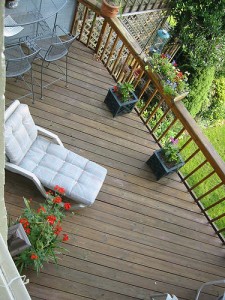
 Pressure treatment protects wood from moisture and decay. It’s a great choice for outdoor projects like decks but there are a few things to you should keep in mind. This post will discuss how pressure treated wood is created, what chemicals are involved, and a few helpful reminders.
Pressure treatment protects wood from moisture and decay. It’s a great choice for outdoor projects like decks but there are a few things to you should keep in mind. This post will discuss how pressure treated wood is created, what chemicals are involved, and a few helpful reminders.
What is Pressure Treated Wood
Pressure treated wood refers to dimensional lumber or plywood that has undergone chemical treatment to resist rot, insects, fungus and more. Pressure treated wood is very durable and has a much longer lifespan (20 years+) than untreated wood. This process makes it an ideal choice for ground-contact or high-moisture projects like decking.
The term, pressure treated, applies to all measures taken to ensure the long life of wood. The standardized process involves placing wood inside a large, airless tank. The tank is filled with the chemical preservative under high pressure forcing it deep into the wood core.
Chemicals Used for Pressure Treated Lumber
There’s a large variety of chemicals that can be used as wood preservative. Wikipedia has an extensive list, but basically there are three main types: water-borne, oil-borne, and creosote. Here’s a list of the most popular chemicals.
- Chromated copper arsenate (CCA) – CCA was a very common chemical to treat lumber; the copper acts as a fungicide, arsenate as an insecticide, and chromium to bind the ingredients to the wood. But in 2003, the EPA restricted its use due to concerns about the wide-spread use of arsenic, a known human carcinogen. It has not been shown that CCA poses an unreasonable risk but it’s better to err on the safe side.
- Alkaline copper quaternary (ACQ) – ACQ is a popular, copper based alternative to CCA. It works in a similar fashion but without the arsenic and chromium.
- Ammoniacal copper zinc arsenate (ACZA) – ACZA is generally used for certain marine applications.
- Copper azone (CA) – CA is similar to ACQ but requires much less chemical to be effective. Wood treated with CA takes on a slightly greenish hue.
Guide for Using Pressure Treated Wood
Pressure treated wood is used for lots of projects like decks, framing a basement, mailboxes, guardrails, picnic tables, docks, and utility poles. Regardless of what chemical is used, the wood is measured in pounds of preservative per cubic foot of wood. Be sure to select the right level of pressure treatment for your project.
- 0.25 lbs./ft³ for above ground usage
- 0.40 lbs./ft³ for wood that comes in contact with the ground
- 0.60 lbs./ft³ for permanent wood foundations
- 2.50 lbs./ft³ for wood in contact with salt water
Special Considerations for Pressure Treated Wood
Here are a couple helpful reminders when working with pressure treated wood.
- Pressure treated saw dust can irritate your eyes, nose and skin. Wear a gloves and a mask for protection. Wash thoroughly after working with pressure treated wood.
- Don’t burn pressure treated wood. The ash contains arsenic and is very toxic.
- Don’t put pressure treated wood in contact with food (i.e. cutting boards). There is some debate online about using pressure treated wood for vegetable gardens. It seems the leach-off is minimal but I still recommend against it.
- Use galvanized screws, nails, and brackets. Un-galvanized screws and nails corrode because of the chemicals in pressure treated wood.
- Wait before staining or weatherproofing. Pressure treated wood needs time to dry out. Manufacturers generally recommend waiting at least 6 months.
What do you think? Any tips for working with pressure treated wood?
Image courtesy of Miki James






